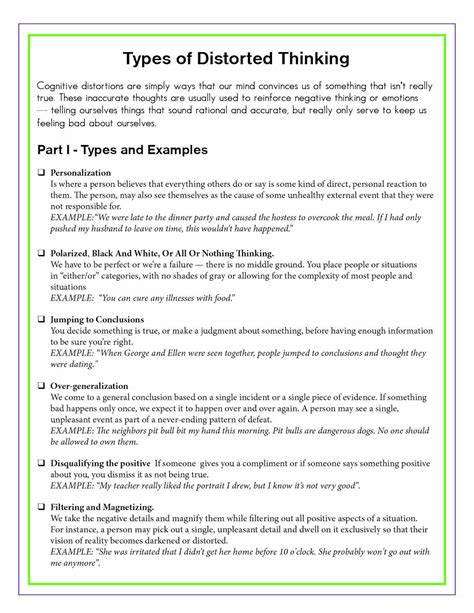Distorted Thinking Worksheet: Transform Your Mindset Now

In the intricate landscape of human thought, distortion can act like a mischievous gremlin, skewing our perception of reality and leading us down paths of undue stress, anxiety, and depression. Cognitive Behavioral Therapy (CBT) offers a valuable tool in the form of the Distorted Thinking Worksheet, which can serve as a powerful instrument to help individuals recognize and transform these cognitive distortions. This post will guide you through the process of using this worksheet effectively, delve into the common types of distorted thinking, and provide practical steps to reframe your thoughts for a healthier mindset.
What are Cognitive Distortions?

Before we dive into the worksheet itself, it’s crucial to understand what we mean by cognitive distortions. These are exaggerated or irrational thought patterns involved in the onset or perpetuation of mood disorders. Here are some common types:
- Black and White Thinking: Viewing situations in an all-or-nothing fashion, with no shades of gray.
- Overgeneralization: Drawing overly broad conclusions from a single event.
- Personalization: Believing that external events are directly connected to you when they aren’t.
- Catastrophizing: Imagining the worst possible outcome without considering more realistic possibilities.
- Discounting the Positives: Ignoring or rejecting positive experiences, convincing yourself they do not count.
Using the Distorted Thinking Worksheet

The Distorted Thinking Worksheet isn’t just a piece of paper; it’s a roadmap for self-discovery and cognitive restructuring. Here’s how you can utilize it:
Step 1: Identify the Distorted Thought

Whenever you notice a shift in your mood, take a moment to write down:
- The situation or trigger that prompted the thought.
- The emotion you’re feeling.
- The automatic thought or what you’re thinking about the situation.
Step 2: Evaluate the Evidence

Using the worksheet, challenge the thought:
- What evidence do I have to support this thought?
- What evidence contradicts this thought?
- What alternative perspectives might there be?
Here, the worksheet prompts you to assess your thoughts as if you were a detective looking for facts, rather than jumping to conclusions.
Step 3: Reframe the Thought

Now that you’ve examined your thought critically, it’s time to:
- Construct a more balanced thought that acknowledges the full spectrum of evidence.
- Consider what a friend might say if they heard your distorted thinking.
- Formulate a counterstatement that negates or softens the initial distortion.
| Distorted Thought | Evidence For | Evidence Against | Reframed Thought |
|---|---|---|---|
| I'm a complete failure. | My last project didn't meet expectations. | I've had many successes, received promotions, and positive feedback. | I had a setback, but I have had numerous successes, and it's one piece of a larger picture. |

💡 Note: The above table is just an example; your worksheet will be customized based on your unique experiences and thoughts.
Practical Steps for Effective Use

Here are some tips to ensure you maximize the benefits of the Distorted Thinking Worksheet:
- Be Consistent: Regularly filling out the worksheet helps you spot patterns over time.
- Be Honest: Authenticity is key to truly benefit from this exercise.
- Reflect: Take time to think deeply about how the thought affects you emotionally and behaviorally.
- Seek Feedback: Discussing your thoughts with someone trusted can provide valuable insights.
- Experiment: Test out the reframed thought in your daily life to see if it’s more accurate and beneficial.
The Power of Transformation

By consistently employing the Distorted Thinking Worksheet, you can gradually shift your cognitive habits. This isn’t about dismissing negative thoughts but about understanding them better and adjusting your mindset to reflect reality more accurately. Over time, this practice can:
- Decrease the frequency and intensity of negative thoughts.
- Increase your ability to manage emotions and reactions.
- Enhance self-awareness and insight into your thought patterns.
- Improve your overall mental resilience and flexibility.
💡 Note: Remember, cognitive restructuring is a skill that takes time to master, and the worksheet is a tool to help you along this journey.
Summarily, using the Distorted Thinking Worksheet offers a structured approach to dissecting and reframing the thoughts that can cloud our mental skies. By understanding how we think, we gain the ability to think better. And with better thinking, comes a more balanced, optimistic, and healthier mindset. This transformative process can lead to significant improvements in how we experience life, allowing us to view challenges as opportunities for growth rather than insurmountable obstacles.
What if my distorted thought feels too true?

+
Even thoughts that feel deeply true can be examined for distortion. Remember, the worksheet is about exploring the full spectrum of evidence, not dismissing your feelings outright. With time and practice, you’ll get better at discerning between what feels true and what is actually supported by evidence.
How often should I use the worksheet?

+
Consistency is key. Using it daily or whenever you catch a distorted thought is ideal. Over time, you might find the need to use it less as you internalize the process of reframing.
Can the worksheet really change how I think?

+
Yes, absolutely. Like any skill, cognitive restructuring takes practice. The worksheet is a guide to help you question, analyze, and adjust your thought patterns, leading to lasting changes in your mindset.
What if I find it hard to reframe my thoughts?

+
Reframing is indeed challenging. Consider discussing your thoughts with a therapist, counselor, or trusted friend to get different perspectives. Sometimes, an outsider’s viewpoint can provide clarity.
Is the worksheet effective for everyone?

+
It can be very effective for many people, particularly those who engage in cognitive distortions. However, some might need additional support like therapy or different coping strategies. It’s not a one-size-fits-all solution but a valuable tool in the cognitive toolbox.